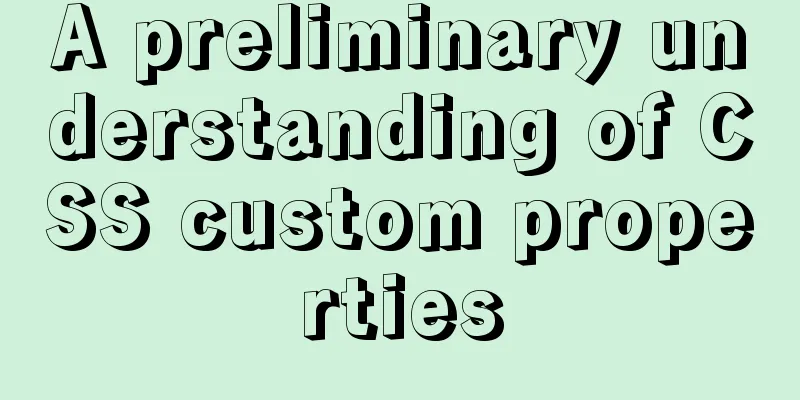A preliminary understanding of CSS custom properties

|
Today, CSS preprocessors are the standard for web development. One of the main benefits of preprocessors is that they enable you to use variables, which helps you avoid copying and pasting code and simplifies development and refactoring. In this article, you’ll learn how to integrate CSS variables into your CSS development workflow, which can make your stylesheets more maintainable and less repetitive. Now, let me get started! 1* CSS variable syntax <1> What are CSS variables? If you have used any programming language, you should already be familiar with the concept of variables. Variables allow you to store and update values that your program needs in order to work. The benefits of using variables in CSS are not too different from the benefits of using variables in programming languages. Here's what the spec says about it: [Using CSS variables] makes it easier to read large files, as seemingly-arbitrary values now have informative names, and makes editing such files much easier and less error-prone, as one only has to change the value once, in the custom property, and the change will propagate to all uses of that variable automatically. W3C Specification . [Using CSS variables] makes it easier to read large files, because seemingly arbitrary values now have informative names, and makes editing such files easier and less error-prone, because a value only needs to be changed once in a custom property, and that change will automatically propagate to all places the variable is used. <2>css custom variable syntax To declare a variable instead of a common CSS property (like color or fill), simply provide a custom named property starting with -:
.box{
--box-color: #4d4e53;
--box-padding: 0 10px;
}The value of a property can be any valid CSS value: a color, a string, a layout value, or even an expression. Here are some useful custom properties:
:root{
--main-color: #4d4e53;
--main-bg: rgb(255, 255, 255);
--logo-border-color: rebeccapurple;
--header-height: 68px;
--content-padding: 10px 20px;
--base-line-height: 1.428571429;
--transition-duration: .35s;
--external-link: "external link";
--margin-top: calc(2vh + 20px);
/* Valid CSS custom properties can be reused later in, say, JavaScript. */
--foo: if(x > 5) this.width = 10;
}If you're not sure about :root, in HTML it's the same as html but with a higher specificity, the equivalent of a global variable. <3> Use of CSS variables var() Function To use CSS variables, you use the var() CSS function, passing the CSS variable name to the function:
.box{
--box-color:#4d4e53;
--box-padding: 0 10px;
padding: var(--box-padding);
}
.box div{
color: var(--box-color);
} The syntax of the var() function is: var( <custom-property-name> [, <declaration-value> ]? ) The first argument to the method is the name of the custom attribute to replace. The optional second argument to the function is used as a fallback value. If the first argument refers to an invalid custom property, the function uses the second value. You can do this if you are not sure whether a custom property has been defined and want to provide a value to use as a fallback. For example: color: var(--foo, red, blue); //Specify both red and blue as fallback values; that is, any value between the first comma and the end of the function will be considered a fallback value. calc() Function As we are used to working with preprocessors and other languages, we expect to be able to use basic operators when working with variables. For this purpose, CSS provides a calc() function, which causes the browser to recalculate the expression after any changes to the value of a custom property:
:root{
--indent-size: 10px;
--indent-xl: calc(2*var(--indent-size));
--indent-l: calc(var(--indent-size) + 2px);
--indent-s: calc(var(--indent-size) - 2px);
--indent-xs: calc(var(--indent-size)/2);
}If you are trying to work with unitless values, using the calc() function can be very convenient:
:root{
--spacer: 10;
}
.box{
padding: var(--spacer)px 0; /* DOESN'T work */
padding: calc(var(--spacer)*1px) 0; /* WORKS */
}CSS custom property scope Custom properties also obey the CSS cascade rules. 2* Use CSS custom attributes with JS Suppose you have a CSS variable called --left-pos with a value of 100px, scoped to the .sidebar class in your CSS document:
.sidebar {
--left-pos: 100px;
}You can get the value of --left-pos as follows:
const sidebarElement = document.querySelector('.sidebar');
const cssStyles = getComputedStyle(sidebarElement);
const cssVal = String(cssStyles.getPropertyValue('--left-pos')).trim();
console.log(cssVal); //100pxSet the CSS property value:
sidebarElement.style.setProperty('--left-pos', '200px');3* What is the difference between css variables and preprocessor variables? When styling your website, you probably take advantage of the flexibility of variables by using preprocessors like Sass and Less. The preprocessor allows you to set variables, and use them in functions, loops, mathematical operations, etc. Does this mean that CSS variables don't matter? Not exactly, mainly because CSS variables are different from preprocessor variables. The difference stems from the fact that CSS variables are real CSS properties that work in the browser, whereas preprocessor variables need to be compiled into regular CSS code, so the browser knows nothing about them. This means you can update CSS variables, inline style attributes and SVG presentation properties within your stylesheet document, or choose to manipulate them dynamically using JavaScript. Modifications to CSS custom properties will be immediately passed to the place where they are used, but preprocessors cannot accomplish this because they are compiled in advance! That’s not to say you need to choose between one or the other: there’s nothing stopping you from taking advantage of the superpowers of CSS and preprocessor variables working together. Summarize The above is my introduction to CSS custom properties. I hope it will be helpful to you. If you have any questions, please leave me a message and I will reply to you in time. I would also like to thank everyone for their support of the 123WORDPRESS.COM website! |
<<: Learn how to use the supervisor watchdog in 3 minutes
>>: In-depth explanation of hidden fields, a new feature of MySQL 8.0
Recommend
Several methods for js to determine the horizontal and vertical screen viewport detection of mobile terminals
Table of contents 1. How to obtain different view...
A brief discussion on front-end production: Is IE6 still necessary for compatibility?
The domestic market still has a certain demand fo...
CSS implements the function of hiding the search box (animation forward and reverse sequence)
Placing a search box in the top menu bar is a com...
Introduction to the use of CSS3 filter attribute
1. Introduction When writing animation effects fo...
How to start the spring-boot project using the built-in linux system in win10
1. Install the built-in Linux subsystem of win10 ...
How to generate mysql primary key id (self-increment, unique and irregular)
Table of contents 1. Use the uuid function to gen...
Problems with index and FROM_UNIXTIME in mysql
Zero, Background I received a lot of alerts this ...
MySQL prepare principle detailed explanation
Benefits of Prepare The reason why Prepare SQL is...
IE6 implements min-width
First of all, we know that this effect should be ...
Docker meets Intellij IDEA, Java development improves productivity tenfold
Table of contents 1. Preparation before developme...
Solve the problem of docker's tls (ssl) certificate expiration
Problem phenomenon: [root@localhost ~]# docker im...
How to configure nginx to return text or json
Sometimes when requesting certain interfaces, you...
Detailed explanation of the usage of 5 different values of CSS position
The position property The position property speci...
How to build your own Nexus private server in Linux
This article describes how to build a Nexus priva...
Basic introductory tutorial on MySQL partition tables
Preface In a recent project, we need to save a la...









